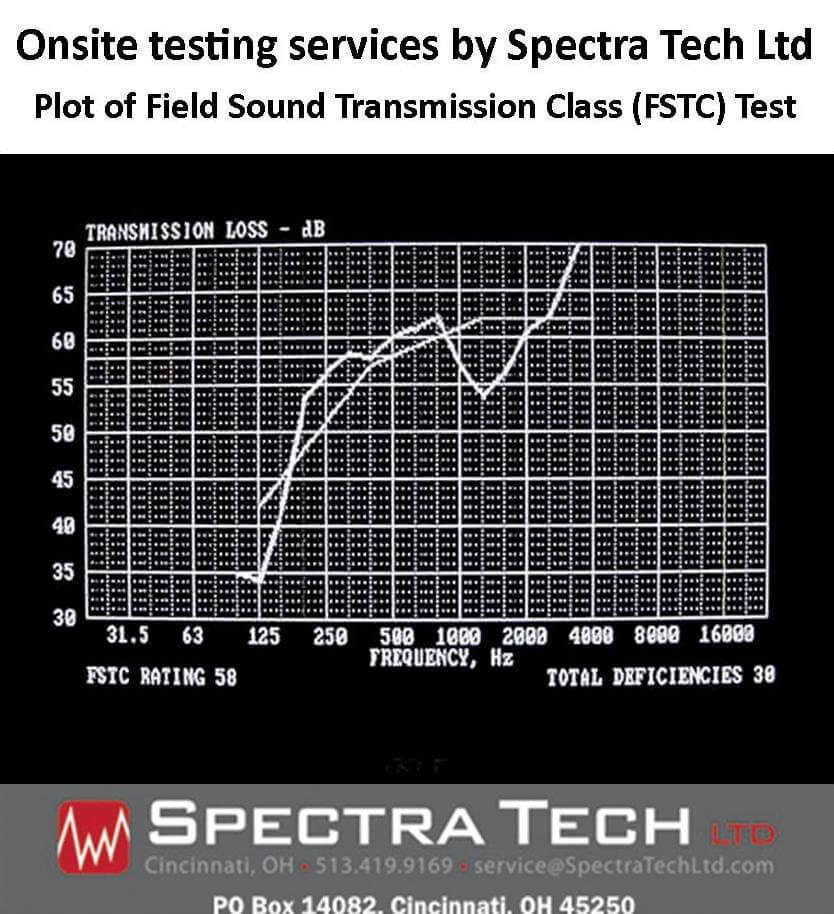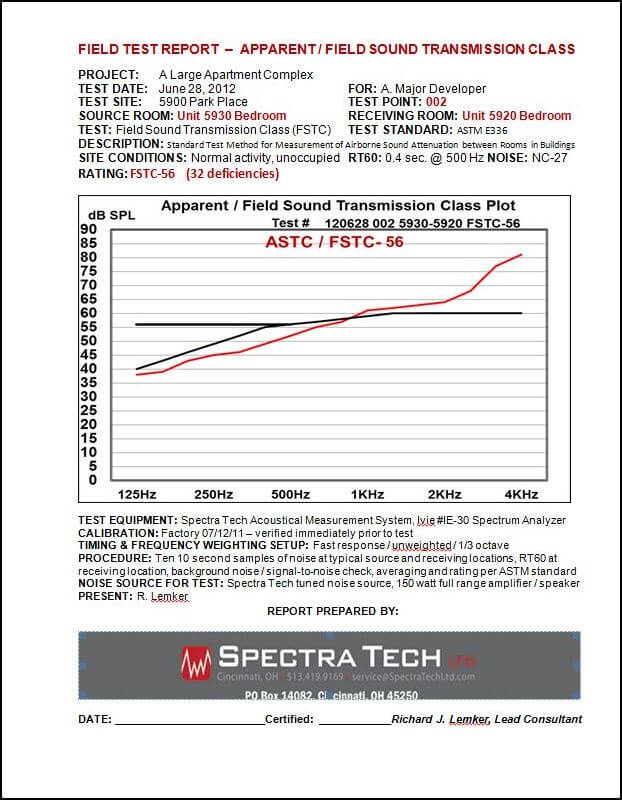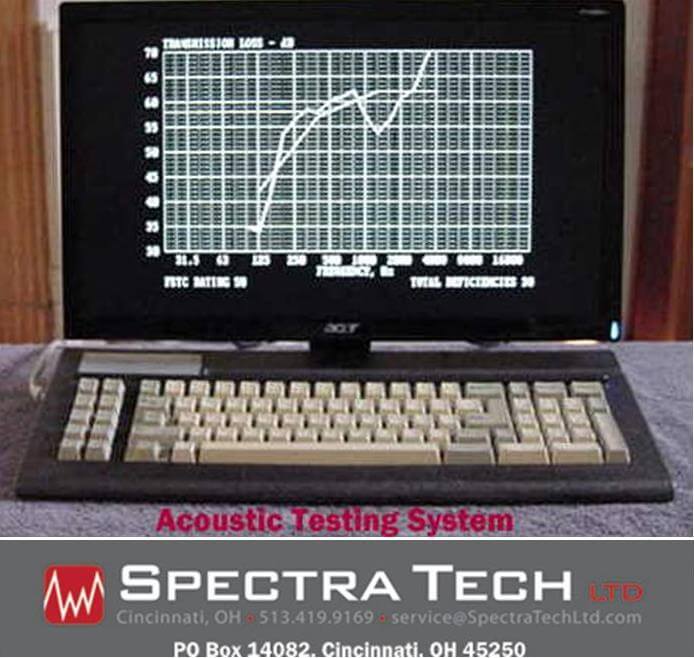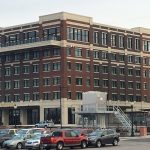Spectra Tech employes sophisticated equipment and software to automatically measure and document Apparent / Field Sound Transmission Class (ASTC / FSTC) values of demising interior elements of construction, including walls, doors, floor / ceiling assemblies, cubicles, and glass. We can also provide assistance in designing solutions to increase the sound isolation provided by demising construction.
- This is the “field” (F) version of testing normally done by product manufacturers to rate the Sound Transmission Class (STC) performance of a product or material when tested in an ideal laboratory setting. STC performance values are nearly impossible to obtain in the field, due to inherent deficiencies associated with field construction.
- The Apparent / Field Sound Transmission Class (ASTC / FSTC) Curves were developed to form a universal standard by which the sound reduction provided by various building materials and design configuraations could be quantified.
- The ASTC / FSTC number is derived from sound attenuation values tested at frequencies from 125 Hz to 4000 Hz. These transmission-loss values are then plotted on a sound pressure level graph and the resulting curve is compared to a standard reference contour. These values are analyzed to determine the appropriate TL Curve (or Transmission Loss) to determine an STC rating. The measurement is accurate for speech sounds, but much less so for amplified music, mechanical equipment noise, transportation noise, or any sound with substantial low-frequency energy below 125 Hz.
Spectra Tech Ltd, data logging computer system, on-site field test - The ASTC / FSTC rating is a single-number descriptor of the decibel reduction in noise a partition can provide.
- To test the transmission of sound through a particular construction, a broadband spectrum of noise is generated at all frequencies between 63 Hz and 8,000 Hz and amplified in the “source” room to provide a level at the receiving side that is sufficiently higher than the receiving room’s normal ambient noise level.
- The average unweighted (fast response) sound levels for each octave frequency band between 125 Hz and 4,000 Hz (4KHz) is recorded at ten random locations on the “source side” of the construction for a period of 10 seconds or more.
- Then, the average unweighted (fast response) sound levels for each octave frequency band between 125 Hz and 4,000 Hz (4KHz) is recorded at ten random locations on the “receiving side” of the construction for a period of 10 seconds or more.
- A reverberation time test is also conducted in the “receiving room” and if the room reverberation is not found to be within the nornal criteria, adjustments to the FSTC rating must be made accordingly.
- The test results are plotted over a family of reference curves, and computations are made to allow for a maximum of 8 dB of deficiencies in any octave band or up to a total of 32 dB of deficiencies in all octave bands combined. The corresponding value of the plot at 500 Hz is the FSTC value.
- For facilities subject to US Government Physical Security Standards for Sensitive Compartmented Information Facilities (SCIF), each element of the room’s perimeter demising construction must meet the specified FSTC criteria (normally FSTC-45 or more) before classified work can be conducted.
- Plot / Print Test Results: We get the results instantly – in the field. We can provide documentation of test results by plotting / printing the test values on paper, and / or provide the reslts in PDF format.
So you have tested your door, wall, or floor/ceiling and it doesn’t meet the project’s ASTC / FSTC criteria – – – – Now what?
We do more than simply give you test results. We can likely help you raise the ASTC / FSTC rating while we are onsite!
- FOR DOORS: Most often, door FSTC performance deficiencies can be traced to the door’s seals. It is likely that there will be no visible or measurable gaps around the perimeter of the door at the seals. We can immediately perform a proprietary “sniff test” (developed by Spectra Tech’s staff for use in our government security testing) to locate the exact point(s) of sound leakage. Within minutes, it is likely that your staff can make necessary adjustments to the door’s seals per our specific instructions. The door can be retested. Sometimes, a few adjustments must be made, but eventually the door ASTC / FSTC value will increase until the targeted ASTC / FSTC rating is obtained.
- FOR WALLS: Deficient wall performance can often be traced to field construction deficiencies. We can immediately perform a proprietary “sniff test” (developed by Spectra Tech’s staff for use in our government security testing) to locate the exact point(s) of sound leakage through the wall.



Our sniffer can even locate deficiencies such as inadequate caulking of drywall – even when these deficiencies are concealed behind a finished baseboard trim strip. Within minutes, it is likely that your staff can install additional caulking and the wall can be re-tested and shown to be in conformance with the project criteria. When the problem is determined to be the result of penetrations that are not readily accessible, or when the overall sound isolation of the base construction is found to be inadequate, we can assist in developing solutions that can be implemented prior to a re-test.
- FOR FLOOR / CEILING ASSEMBLIES: We can often trace the sound isolation deficiencies to penetrations in the floor / ceiling surfaces that have not been properly sealed. Within minutes, it is likely that your staff can install additional caulking in accessible penetration openings, and the floor / ceiling can be re-tested. When the problem is determined to be the result of penetrations that are not readily accessible, or when the overall sound isolation of the base construction is found to be inadequate, we can assist in developing solutions that can be implemented prior to a re-test.
For a comprehensive list of acoustical measurement variables and criteria that can be measured and / or computed, please visit Detailed Measurement Specifications & Definitions
For specifications on our primary audio test equipment, please visit Audio Test System Specifications
- Achieving Privacy: A Major Challenge for Urban Property Re-developers – A Major Problem for Tenants
- ACOUSTIC PRIVACY, SPEECH INTELLIGIBILITY, AUDIO SECURITY, Office, Education, Residential, Spectra Tech Ltd, Consultant
- Silent Guard Virtual Sound Lab – demonstrates the sound isolation for windows with various STC /OITC ratings using several exterior noise sources (link at Silent Guard website)
- Onsite, On-site, Speech Privacy, Privacy, Testing, Sensitive Compartmented Information Facility, SCIF, Proves Its Value, Spectra Tech Ltd, Consultant
- Guide, Speech, Privacy, Test, Printout, Spectra Tech Ltd, Consultant

